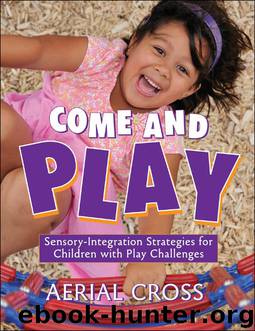Come and Play by Aerial Cross

Author:Aerial Cross [Cross, Aerial]
Language: eng
Format: epub
Publisher: Redleaf Press
Anxious Anne
One thing Anne finds most pleasurable is spending time with her father. Every day after school she waits by the window for him to arrive home from work—her nose pressed against the glass. Her father works at a car dealership as a mechanic. The job is physically demanding. Even at her young age, Anne is well aware of the toll the job takes on her father’s body and moods. His day at work determines the direction of their evening time together, signaled to Anne by the stains on his work clothes. A heavily grease-stained shirt says, “I’m tired and want to be left alone. I’ve had a hard day. I’m worn out.” A clean shirt, on the other hand, usually means he had a slow day; it says, “I finished my shift early without any complications. You can spend time with me. We’ll share our day. You can sit on my lap, and we’ll thumb wrestle each other.” The five to ten seconds it takes for Anne to see the cleanliness of the shirt are nerve-racking to her. They are seconds filled with nervousness and worry. “Clean shirt or greasy shirt? Time playing with Daddy or walking on egg shells?” Unfortunately, anxiety over the shirt’s cleanliness arises well before Anne’s school day ends, commonly during afternoon playtime. The peculiar anxiety-producing event disturbs Anne’s play patterns. Her creativity and focus as well as her ability to productively play all suffer.
Like Anne, children who appear anxious in play often play with apprehension, discomfort, and tension. Anxious children are often afraid to make eye contact with their peers during play. They engage in play activities timidly. An anxious child often enters into play as if afraid of it inflicting a sudden surprise. Although anxiety can be vented through various behaviors, if a child is displaying the following behaviors persistently, in a consistent pattern over an extended period of time, then an anxious play challenge may exist:
•The child freezes up, throws a tantrum, or becomes aggressive when asked to perform a play task.
•The child clings when separation from a parent or teacher is required for play. This is commonly referred to as separation anxiety and may happen at the start of each school day.
•The child obsessively fears unrealistic situations such as birds flying through open windows or closet monsters.
•The child insists on doing everything “just right” for approval.
•The child appears excessively nervous, irritated, or worried.
•The child only watches, suddenly withdraws, or begins to self-soothe through coping mechanisms such as nail picking, thumb sucking, hair twisting, or chewing.
A child’s anxiety becomes problematic during play when she is unable to focus or remain at task long enough to learn from the activity. Luckily, “studies have shown that about 90 percent of all anxious children can be greatly helped by learning coping skills” (Dacey and Fiore 2000, 2). Journaling when and how children experience anxiety, taking detailed notes, is highly important. Doing so will help in discovering patterns or situational fears.
Download
This site does not store any files on its server. We only index and link to content provided by other sites. Please contact the content providers to delete copyright contents if any and email us, we'll remove relevant links or contents immediately.
The Art of Coaching Workbook by Elena Aguilar(50761)
Trainspotting by Irvine Welsh(21461)
Twilight of the Idols With the Antichrist and Ecce Homo by Friedrich Nietzsche(18457)
Fangirl by Rainbow Rowell(9034)
Periodization Training for Sports by Tudor Bompa(8102)
Change Your Questions, Change Your Life by Marilee Adams(7574)
This Is How You Lose Her by Junot Diaz(6709)
Asking the Right Questions: A Guide to Critical Thinking by M. Neil Browne & Stuart M. Keeley(5582)
Grit by Angela Duckworth(5455)
Red Sparrow by Jason Matthews(5327)
Paper Towns by Green John(5030)
Room 212 by Kate Stewart(4968)
Ken Follett - World without end by Ken Follett(4602)
Housekeeping by Marilynne Robinson(4259)
The Sports Rules Book by Human Kinetics(4221)
Papillon (English) by Henri Charrière(4153)
Double Down (Diary of a Wimpy Kid Book 11) by Jeff Kinney(4151)
The Motorcycle Diaries by Ernesto Che Guevara(3939)
Exercise Technique Manual for Resistance Training by National Strength & Conditioning Association(3912)
